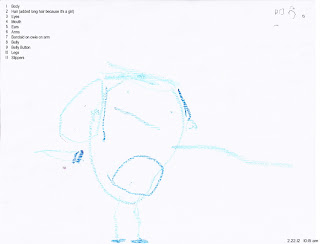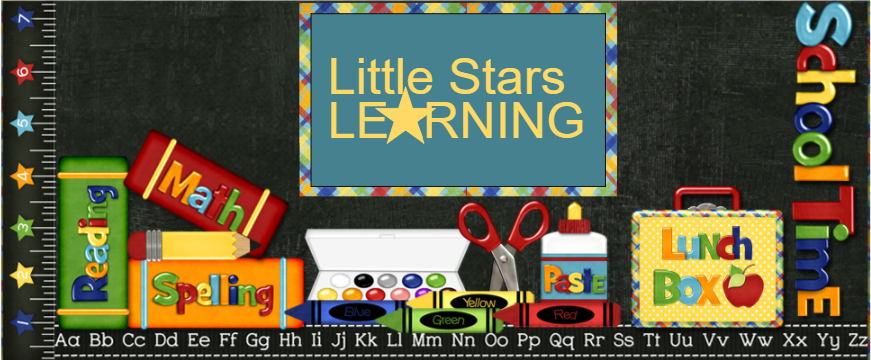"My 3 year old is learning her letters and numbers,
is she ready to begin writing?"
is she ready to begin writing?"
My response, links in green:
WHERE IS YOUR CHILD AT?
- Do they have the fine motor skills? Holds a pencil or crayon with a tripod or modified tripod grip [develops naturally, should not be forced] and applies enough pressure to create intentional forms.
- Do they have the crossing-the-midline development? Reaches across the body to grab items with the dominate hand, throws a ball or Frisbee across the body.
- Do they have the visual perception and spatial skills? Do they know the difference between b/d/p, even if they get them incorrect most of the time?
- Are they making lines and circles during independent drawing?
- Are they making recognizable figures during independent drawing? Identifiable by others, and not just the child.
Fine motor coordination/ability often develops much later than cognitive ability. A child's brain will work on building one skill set at a time. Their focus of learning vacillates between cognitive and motor skills.
Gross motor ability is often mistaken for being an indicator of fine motor skill. This is simply not so. A child may be able to throw a ball with accuracy, but still not be able to feed themselves without dropping food all over the place.
Here is an excellent visual of the 12 stages of Developmental Progression in Children's Writing by Heidi Butkus. I couldn't have done it better, so I'm just linking to her's. I have this laminated on the wall above my desk. http://www.heidisongs.com/Free_Downloads/assets/Stages_Of_Childs_Writing.pdf
Next to it, I have this Drawing Development in Children chart beautiful illustrated by Susan Donley.
My Miss B's drawing at 3 3/4 years.
 |
| Click to open larger for detail |
Prior to any type of formal writing, a child must develop upper body muscle strength, trunk stability and gain some mastery of his fine motor skills. Developing the muscles is necessary prior to even picking up a crayon, let alone attempting to write with any accuracy. Much of the necessary development occurs during crawling.
[Often older children, kindergarten and even higher, who lack upper body muscle, fine motor, trunk stability and crossing-the-midline development, will be instructed to crawl around.]
If the motor skills are in place, then they must still learn the conventions of how to hold on to the writing utensil, apply enough pressure to produce the desired effect, and get it to move in the desired way. All of this takes practice.
[Often older children, kindergarten and even higher, who lack upper body muscle, fine motor, trunk stability and crossing-the-midline development, will be instructed to crawl around.]
If the motor skills are in place, then they must still learn the conventions of how to hold on to the writing utensil, apply enough pressure to produce the desired effect, and get it to move in the desired way. All of this takes practice.
 |
| [Unable to follow this image to its original source. Link attached to image.] Even at 1, these two are already using a modified tripod grasp. No instruction necessary. |
Worksheets are not developmentally appropriate for children under the age of seven. YES, the school districts use them, but it is for convenience and assessment, not because it's right. Worksheets are not engaging, require too fine of dexterity for a child to be successful, and have a right/wrong outcome which can cause a child needing more muscle control to lose interest to the point of shutting down on doing any writing activity.
'You need to work at staying on [in] the line better,' will shut a child down from wanting to learn how to write.
Engaging alternatives include:
- Salt/sand writing
- Shaving cream writing
- Paint/gel bag writing
- Drawing with colored ice cubes
- Drawing with sticks in the dirt
- Finger painting
- Drawing with pencils, crayons, chalk, etc. on a variety of materials/surfaces
- Painting of any kind
- Having the child trace with a wet Q-tip over letters or words written on a chalkboard
- Tracing large letters, sandpaper letters, etc. with a finger
I have salt writing, paint bags, pencils, crayons, chalk and chalk boards inside and outside, Magna Doodles, and white boards readily available for the children to use as they will. They are encouraged to write in some manner all the time, and DO. It's not a curriculum, as much as a way of life, learning through play opportunities.
 |
| Frisbee, salt, unsharpened pencil, shape cards Cards available with my Shape set $1.50 on TPT |
I do not MAKE them participate, however they are not suppose to randomly scribble. They may DRAW whatever they wish, even if they choose to DRAW a scribble. There is a difference.
I have three early learning goals that I begin upon as soon as a child is old enough to communicate.
- The understanding that they should have a purpose every time they pick up a pencil, pen, crayon, paint brush, etc. What are you going to draw? What are you drawing? What did you draw? Usually I will get three different answers on the same drawing until about age 5, which is fine. The goal is to get them THINKING about their PURPOSE.
- The understanding that they have something worthwhile to communicate, that anything they write or draw has meaning. "Tell me about your drawing. May I write this down?"
- The understanding that written words have power. They can tell a story, organize a list, advertise products, provide information, convey meaning, and most importantly, immortalize the child's thoughts.
SHOULD YOUR CHILD
BE WRITING?
BE WRITING?
- Do they like to draw?
- Do they ask for you to help them write their name?
- Do they inquire about print?
- Do they attempt to write lists, books, menus, etc. during play?
- Do they ask you to write for them?
- Do they have stories to tell about their pictures rather than just a statement?
Fine motor tasks can be very frustrating for young children. The success of any new skill set is dependent upon the child's interest and motivation.
Usually, the first thing a child wants to learn to write is their name. By picking a single letter, the simplest one, to begin upon, you increase the chance of the child's success and interest.
Usually, the first thing a child wants to learn to write is their name. By picking a single letter, the simplest one, to begin upon, you increase the chance of the child's success and interest.
When we begin writing, once I begin to see the indicators listed, then we start with sticks and balls. A, C, E, F, H, I, L, O, P, Q, T, a, b c, d, e, i, l, o, p, q, t, are all letters that can be made with sticks and balls with no cross-overs or looping.
Q they usually make in the beginning with the line going straight down. It gradually moves to a diagonal, and that's when I know to begin on the cross-over letters and loops.
Sticks and balls heads outside with us, where it often becomes sticks and rocks, string and leaves, shoes and saucers, etc.. You'd be surprised how many play items can be utilized to create stick and ball/line and circle letters.
Each child is vastly different in temperament, motor skills, cognitive skills and interests. I am not looking for them to reach specific levels of progress within a specific time frame. I simply look for some indication of forward progression.
That is not to say, however, that skills won't take a backward turn. This is especially true when life upheavals or new paradigm shifts take place for the child. I always work from the place the child is at currently, rather than looking to where they have been, when there is regression, or create any pre-conceived idea of where they SHOULD be.
None of that matters.
As with any education, it matters only where the child is AT and where the specific child is currently heading.
Q they usually make in the beginning with the line going straight down. It gradually moves to a diagonal, and that's when I know to begin on the cross-over letters and loops.
Sticks and balls heads outside with us, where it often becomes sticks and rocks, string and leaves, shoes and saucers, etc.. You'd be surprised how many play items can be utilized to create stick and ball/line and circle letters.
PROGRESSION
Each child is vastly different in temperament, motor skills, cognitive skills and interests. I am not looking for them to reach specific levels of progress within a specific time frame. I simply look for some indication of forward progression.
That is not to say, however, that skills won't take a backward turn. This is especially true when life upheavals or new paradigm shifts take place for the child. I always work from the place the child is at currently, rather than looking to where they have been, when there is regression, or create any pre-conceived idea of where they SHOULD be.
None of that matters.
As with any education, it matters only where the child is AT and where the specific child is currently heading.
If your child IS ready to write, you may be interested in my blog post on Teaching Penmanship.
Tags: writing, fine motor, child, motor, tripod, grasp, drawing, coloring, art, craft, instruction, early, age, progression, pre-writing, write, name,
letters, formation, letter, number,





















Thank you for sharing all this information. I've pinned it as a reminder :)
ReplyDeleteThis blog post has been selected to feature on Monsters Ed Homeschool Academy's Hearts of the Home Blog Hop post which will go live on Thursday. Congratulations! http://monstersed.wordpress.com/2013/08/01/hearts-of-the-home-blog-hop-10
The blog post has moved to http://monstersed.co.za/2013/08/01/hearts-of-the-home-blog-hop-10/
DeletePlease remember to snag the "I was featured" button ;)
Thank you! I'm evidently not getting comment notifications and just saw this. I grabbed the button. I feel it's important information, so thank you very much for giving me a forum.
Delete